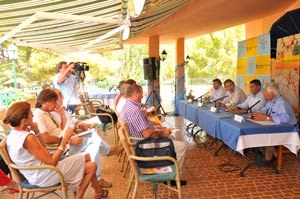The sailing clubs of Salou and Santa Ponça organize this important yacht race which will be held within the Rei en Jaume festivities framework, between 8th and 10th September.

The Santa Ponça sailing club has carried out the presentation of the Rei en Jaume yacht race, which this year holds its 25th edition with its traditional route between the town of Salou (Tarragona) and the Calvià municipality coast lines, this morning.
As it is known, the yacht race commemmorates the conquest of Majorca by the King Jaume I, who came with his fleet from the Catalan town to Majorca, in 1229.
His ships, after anchoring, at first, on the Pantaleu small island next to San Telmo, arrived to the Santa Ponça cove where his troops disembark took place starting, therefore, the occupation on the island.
To commemmorate this event, the Town Halls of Calvià and Salou organize every year, since 1987, a yacht race between both localities, an event which has reached a preferencial place within the Calvià ´s wide festivities programme.
The sailing clubs of Santa Ponça and Calvià are in charge of the competition´s technical organization, an important 110 mile-route yacht race. The vessels, measured under the standard expressions of IR and ORC will be able to participate in this year´s edition and will start from Salou on Friday 9th September arriving to Majorca, predictably, on Saturday 10th. The competition is part of the Mediterranean Area´s High Category Spanish Championship, and in which the participation of about 20 vessels, is estimated. Nevertheless, despite the Catalan vessels greater participation, the winner of the last edition was the Majorcan "Pinyol Vermell" of the competitor Félix Comas de Hevia who spent, doing the route, 25 hours, 36 minutes and 20 seconds.
The "Rei En Jaume" yacht race is one of the most important competitions of high category, carried out in the Balearics and as happens in this type of competitions, it develops the crew´s navigation capacities and requires an adequate interpretation of the weather conditions, changeable in this time of the year -middle of September- in which it is held.




